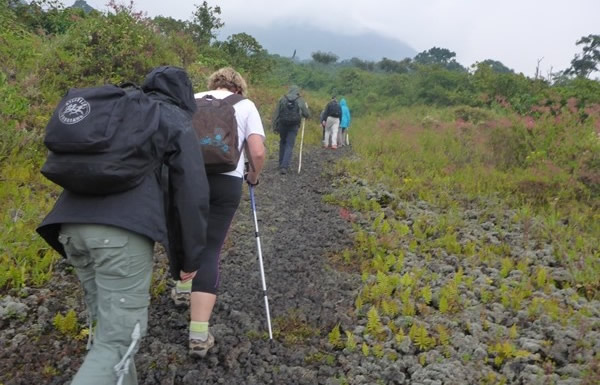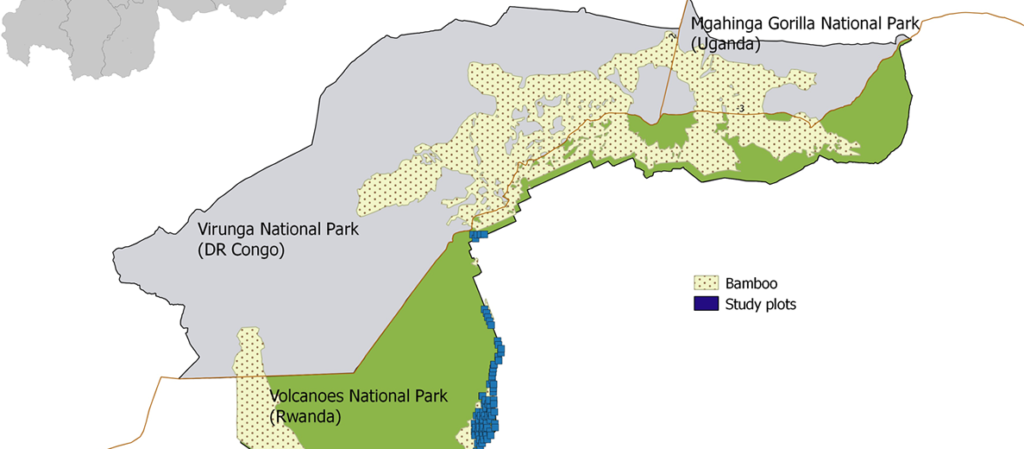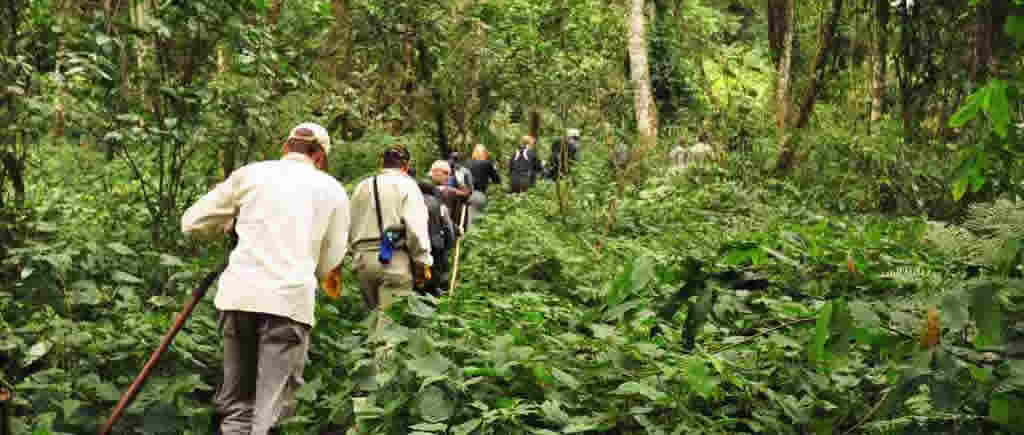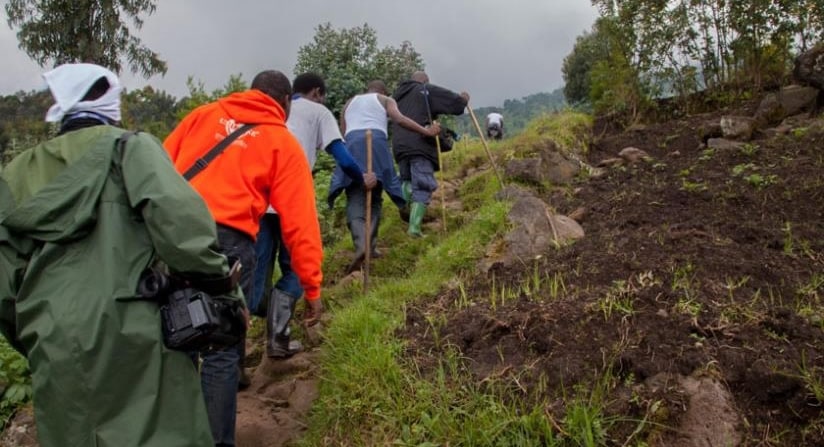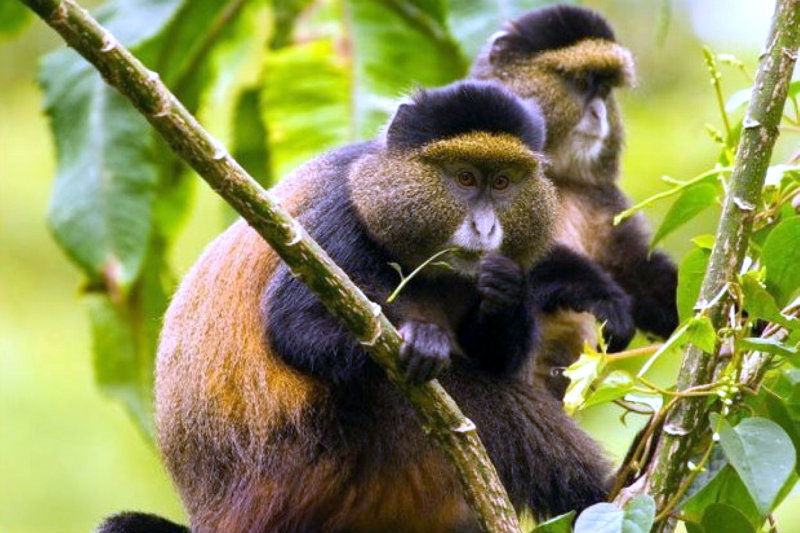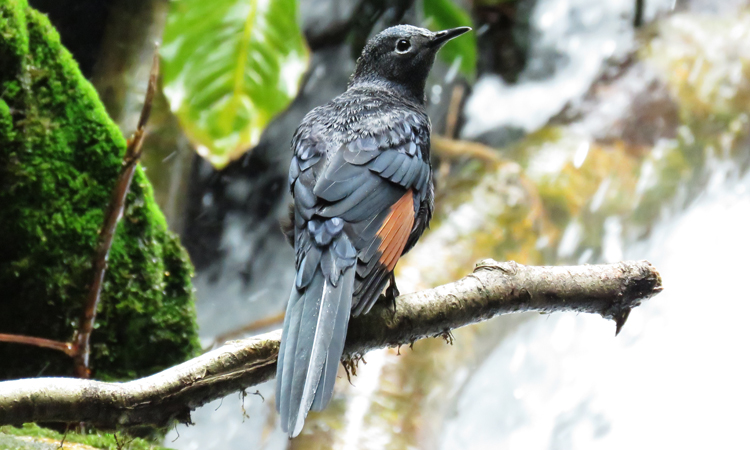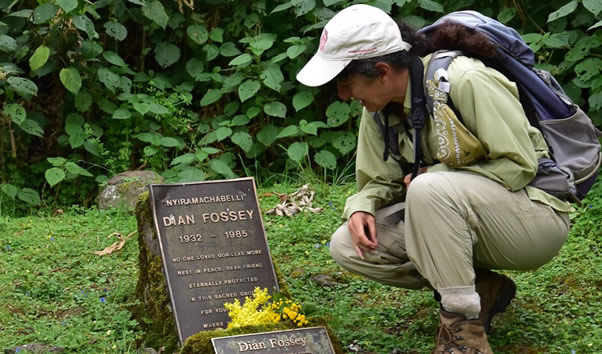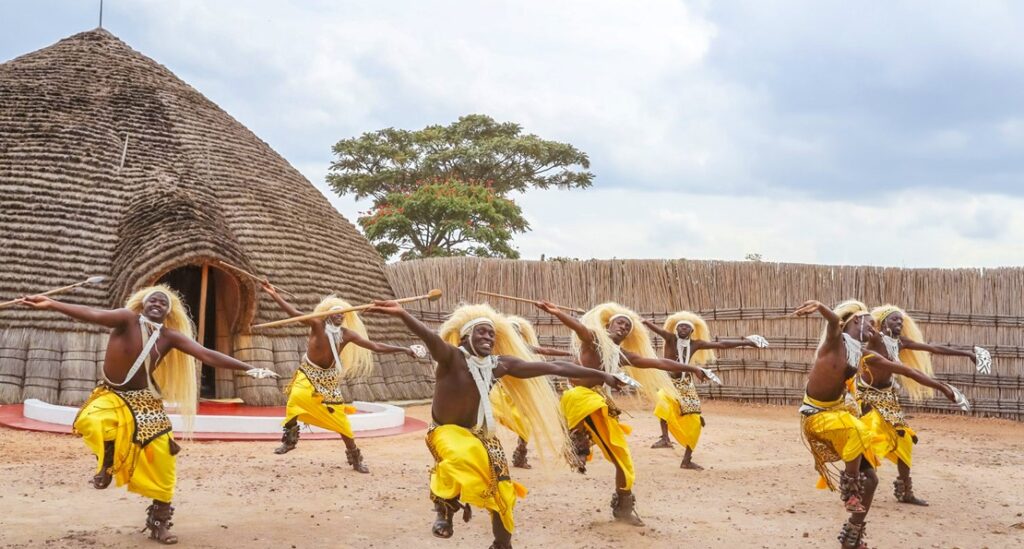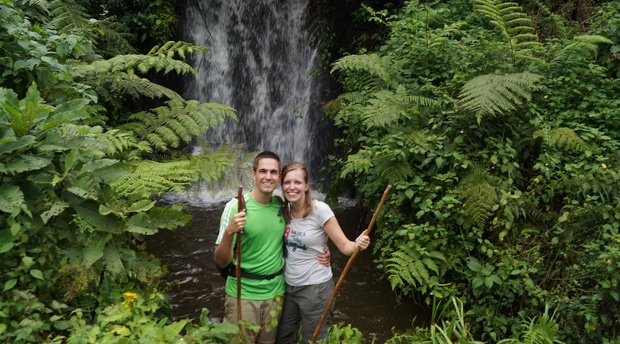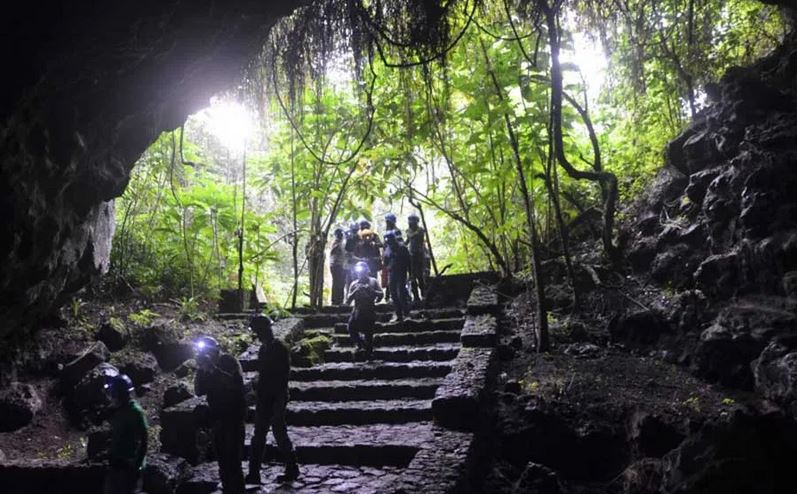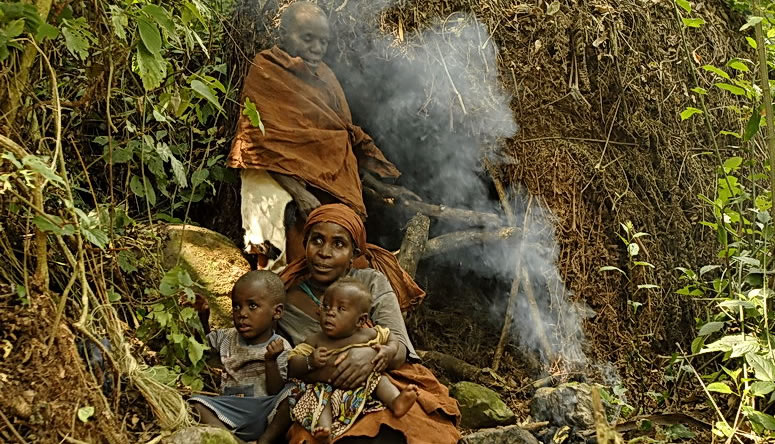Volcano climbing in Rwanda is done in Volcanoes National Park, a habitat for mountain gorillas and golden monkeys. The most popular hikes include 2-day Mount Karisimbi, 1-day Bisoke hikes, and a hike to the Dian Fossey Tomb. These activities begin at the Kinigi visitor center which is at the base of the 8 Virunga Massif. In addition, there are volcanic crater-filled lakes and papyrus swamps in the vicinity of the park including the twin lakes of Burera and Ruhondo and Rugezi swamp. Visitors can go on day trips to the local community and explore the Rwanda local community.
Hiking in Musanze
Musanze town, the capital city of Ruhengeri Northern Province of Rwanda is 10.5 km away from the gorilla trailheads at Kinigi. As the 4th largest metropolis of Rwanda, it can accommodate visitors with nice places to stay and eat and arrange your logistics for daily volcano climbing excursions. Furthermore, the Musanze is just 76 km (2-hour drive) north of Lake Kivu, in Gisenyi or Karongi resort towns. There’s a public beach and several hotels offer private access to the beach and lake islands, making for a perfect place to relax after volcano climbing. Rwanda offers a wide range of adventure travel opportunities available for booking through Rwandan Development or a tour operator. Those intending to climb volcanoes can also explore the Congo Nile biking trails which start in Gisenyi through Karongi and end in the Ruzizi town near Nyungwe Forest National Park in the southwest of Rwanda.
Volcanoes to climb while visiting Rwanda
Mount Karisimbi
 The Karisimbi volcano (4,507m (14,787 feet) is dormant and the tallest among the 8 Virunga Mountains. It is thought to have been formed during the Pleistocene period about 130,000 to 900,000 years ago, thus younger than the Sabinyo and Mikeno (DR Congo). Karisimbi volcano has a depression devoid of water but sometimes the top is covered in thick mist. (Karisimbi means “thick clouds” in English). This 2-day volcano climb begins at Kinigi and the first day involves hiking to the campground where you stay in tents. On the second you hike to the top and return straight to Kinigi. Visitors can hire porters and a cook at extra cost to assist with the arrangement of meals and carry luggage. However, Karisimbi can also be completed in a single day. In regard to that, the 1-day Karisimbi hike can last 7 to 9 hours depending on the experience and pace of the hikers. No technical gear is required, though hiking is challenging due to the nature of the terrain. The permit cost is $300 per person and includes the fee for rangers and guides. However, you can carry some extra cash to tip your ranger as appreciation. The guides will help to identify flora and fauna, mostly birds and occasionally some gorilla encounters.
The Karisimbi volcano (4,507m (14,787 feet) is dormant and the tallest among the 8 Virunga Mountains. It is thought to have been formed during the Pleistocene period about 130,000 to 900,000 years ago, thus younger than the Sabinyo and Mikeno (DR Congo). Karisimbi volcano has a depression devoid of water but sometimes the top is covered in thick mist. (Karisimbi means “thick clouds” in English). This 2-day volcano climb begins at Kinigi and the first day involves hiking to the campground where you stay in tents. On the second you hike to the top and return straight to Kinigi. Visitors can hire porters and a cook at extra cost to assist with the arrangement of meals and carry luggage. However, Karisimbi can also be completed in a single day. In regard to that, the 1-day Karisimbi hike can last 7 to 9 hours depending on the experience and pace of the hikers. No technical gear is required, though hiking is challenging due to the nature of the terrain. The permit cost is $300 per person and includes the fee for rangers and guides. However, you can carry some extra cash to tip your ranger as appreciation. The guides will help to identify flora and fauna, mostly birds and occasionally some gorilla encounters.
Climbing Bisoke Volcano
 Mount Bisoke (3711m) (12,175 feet) is considered dormant, though it had its last volcanic eruption in 1957. The main feature is a water-filled crater lake on the summit. Though hiking is challenging due to the nature of the terrain, there hasn’t been too much soil erosion and the terrain isn’t rough. The 1-day Bisoke climb lasts 3.5 hours to ascend to the top and 4 hours to come back. Descending down the steep slopes is less strenuous but challenging, though Bisoke is the easiest volcano climbing trip in Rwanda. Besides, visitors will walk at the pace of the slowest person in the group. Time for rest stops is also dedicated to taking pictures and listening to wildlife calls. Birds are the most commonly seen including the regal sunbird, one of the 16 Albertine Rift Valley Rift Endemics in Volcanoes National Park. Golden monkeys and gorillas’ encounters have been recorded along the Bisoke trail but there are no guarantees.
Mount Bisoke (3711m) (12,175 feet) is considered dormant, though it had its last volcanic eruption in 1957. The main feature is a water-filled crater lake on the summit. Though hiking is challenging due to the nature of the terrain, there hasn’t been too much soil erosion and the terrain isn’t rough. The 1-day Bisoke climb lasts 3.5 hours to ascend to the top and 4 hours to come back. Descending down the steep slopes is less strenuous but challenging, though Bisoke is the easiest volcano climbing trip in Rwanda. Besides, visitors will walk at the pace of the slowest person in the group. Time for rest stops is also dedicated to taking pictures and listening to wildlife calls. Birds are the most commonly seen including the regal sunbird, one of the 16 Albertine Rift Valley Rift Endemics in Volcanoes National Park. Golden monkeys and gorillas’ encounters have been recorded along the Bisoke trail but there are no guarantees.
Dian Fossey Tomb Hike
 Dian Fossey was an American primatologist who lived for nearly 20 years in a cabin located in a saddle between Karisimbi and Bisoke volcanoes in Volcanoes National Park. During her research and study of mountain gorillas for nearly 20 years, she established the Karisoke center in 1967 which later evolved into the Dian Fossey Gorilla Fund International (DFGFI) – the world’s leading organization in the protection and conservation of mountain gorillas while supporting the sustainable livelihoods of local communities living adjacent to the protected area. Gorillas were near the verge of extinction due to human poaching and encroachment. Fossey’s approach to stopping was rather perceived as ha
Dian Fossey was an American primatologist who lived for nearly 20 years in a cabin located in a saddle between Karisimbi and Bisoke volcanoes in Volcanoes National Park. During her research and study of mountain gorillas for nearly 20 years, she established the Karisoke center in 1967 which later evolved into the Dian Fossey Gorilla Fund International (DFGFI) – the world’s leading organization in the protection and conservation of mountain gorillas while supporting the sustainable livelihoods of local communities living adjacent to the protected area. Gorillas were near the verge of extinction due to human poaching and encroachment. Fossey’s approach to stopping was rather perceived as ha
sh by some of the local people who enviously murdered her in 1985. Despite her death, the hike keeps her legacy alive and reminds us of what we can do as travelers to support the conservation of endangered species. From planting a tree at your lodge to visiting ex-poachers’ projects such as the Gorilla Guardians Center.
Best time for volcano climbing
The best time for volcano climbing in Rwanda is the dry season from June to September and December to February. During this time, the paths in the forest tend to be dry. To some extent, hiking is easier, however, physical fitness is required due to the nature of the terrain. The sun can be scorching; therefore, hiking will likely begin early in the morning so that by midday when it gets hotter, you’re nearly reaching the summit. This is especially for a 1-day Bisoke volcano hike.
Planning a volcano climbing trip in Rwanda
Most of the volcano climbing trailheads are relatively short distances away from the main briefing point. Therefore, self-drive visitors need to arrange transportation on time through a local tour guide. Booking for volcano climbing permits is available through Rwanda Development Board head office in Kigali capital city or a tour operator.
Hikers should expect to start the day early in the morning. Upon returning from the hike, visitors can take tea at the Beyond gorilla experience camp at Kinigi.






